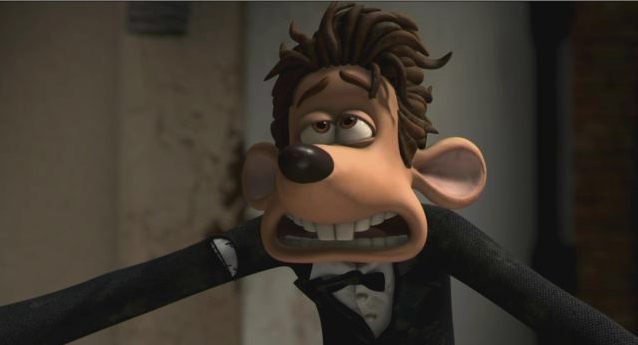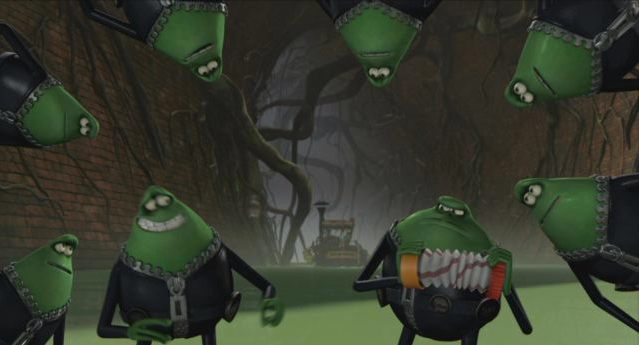Flushed Away (David Bowers & Sam Fell, 2006)
In the opening minutes of Flushed Away, the rat Roddy (voiced by Hugh Jackman), who spends a life of leisure as a solitary house pet, gets flushed down the toilet. He enters the sewers of London where he finds a whole society of rats: initially horrified, he wants nothing more than to escape from the proletarian rats (proletarirats?) and to reach the surface. But with the help of the attractive Rita (voiced by Kate Winslet) he comes to savour the company of his fellow rats.

This might sound a little familiar: how many computer animated films have we seen in the last couple of years about anthropomorphised animals that leave their usual environment and go on a grand adventure, learning salutary lessons along the way about the importance of their fellow animals? What with Finding Nemo and Madagascar and The Wild and Over the Hedge and Open Season and the Ice Age films and now Flushed Away, there’s no doubt that the market for computer animation has become brutally overcrowded, without an accompanying broadening of the horizons in terms of content. It leaves you yearning for the simpler days when you could rely on the elegant simplicity of Pixar and DreamWorks pitching their uncomfortably similar projects against each other.
Your best hope in trying to pick films from this crowd is to stick the quality studios with a proven track record, and for many, that has basically meant Pixar. But Flushed Away sees the British studio Aardman (in alliance with DreamWorks animation) joining the computer-animation revolution. They do so after forging an impressive reputation in stop-motion animation with the Wallace and Gromit shorts and the feature films Chicken Run and Curse of the Were-Rabbit. With this pedigree, we have considerable reason to expect a lot of Flushed Away, and for the most part it delivers. This is a funny film, and kids and adults will have a great time with it. Yet something always feels off. I watched it with some of the same suspicion with which Kevin McCarthy watches his fellow townsfolk in Invasion of the Body Snatchers: it looks like Aardman, it sounds like Aardman, but the heart and soul isn’t there.
Impeccable care has been taken in the production of the facsimile. The switch to computer animation, for example, has been carefully done so that most audiences will barely perceive the switch. The design of the characters retains the distinctive Aardman “look,” and carefully imitates the look of clay models. (One advantage of this is that it humanises the rats and avoids the unappealing “rattiness” of the character designs in Pixar’s upcoming Ratatouille.) This extends to replicating the texture of clay, and eccentricities of animation that would usually be considered failures of the stop-motion technique. There’s an element of redundancy in such an exercise, like watching computer animators in the Star Wars prequels using computers to arduously replicate the Yoda puppet (guys, just use a puppet!). It does, however, allow for big crowd scenes and scenes on water that would be impossible with stop motion. Still, I missed the impeccably assembled “old-school” feel of stop-motion: it feels like it’s made by craftspeople, rather than technicians.
It’s quite unfair to criticise the film on the basis of its technology, of course, but the faking of the stop-motion “look” is representative of the film’s more general sense of uncomfortable artifice. Even the Britishness of the film seems forced. The British sensibility in the Wallace and Gromit films may have been a little twee, but it had an authenticity to it. The references to London and British culture in Flushed Away are of the touristy, picture-postcard type. As a result, it feels like a Dreamworks film with British iconography grafted on: it’s as British as a Union Jack baseball cap.
This mid-Atlantic feel extends to its plot and gag construction. It’s an expertly done film, with the jokes precisely timed and the action scenes suitably rousing. Yet the jokes are very often standard types of gags, effective but formulaic, and reminiscent of American animation films. For example, there’s an elite squad of French frogs that exploits animation’s suitability for creating comedy from groups of characters with highly synchronised movements. It’s a type of joke with a long heritage, but it’s been practically compulsory in the last few years: think of the penguins in Madagascar, or Robin Hood’s gang in Shrek, or the dodos in Ice Age. It’s still funny, but this kind of interchangeable, off-the-shelf joke does little to distinguish Flushed Away from its competition. Even the scheme of the main villain seems plugged in from Antz.

Is it fair to be so harsh on the film just because it’s merely good, when it comes from those from whom we expect unfailing excellence? Not really. If this was from another studio I would probably have been pleasantly surprised by it. But I still hope this doesn’t represent the future of Aardman, and take comfort in the thought that following this film Aardman and Dreamworks dissolved their partnership, citing creative differences. Hopefully, their next film will see a return of some of the charm so evident as recently as Curse of the Were-Rabbit.